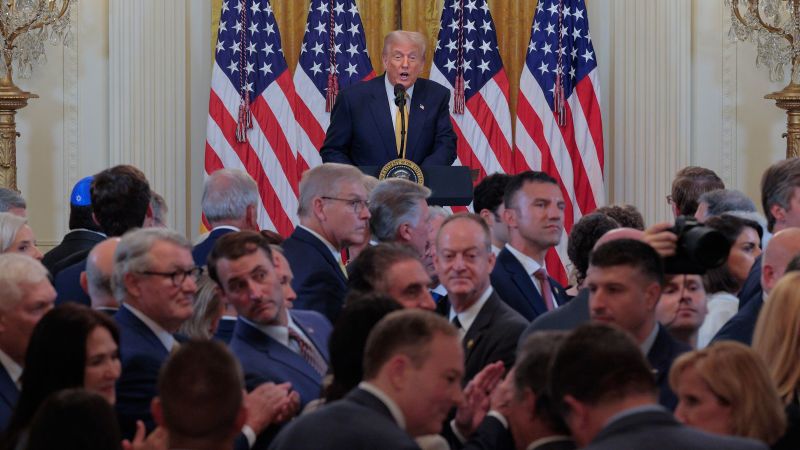Voter Persuasion: The Trump Administration's Strategy For Passing Its Agenda Through Tax Cuts

Welcome to your ultimate source for breaking news, trending updates, and in-depth stories from around the world. Whether it's politics, technology, entertainment, sports, or lifestyle, we bring you real-time updates that keep you informed and ahead of the curve.
Our team works tirelessly to ensure you never miss a moment. From the latest developments in global events to the most talked-about topics on social media, our news platform is designed to deliver accurate and timely information, all in one place.
Stay in the know and join thousands of readers who trust us for reliable, up-to-date content. Explore our expertly curated articles and dive deeper into the stories that matter to you. Visit Best Website now and be part of the conversation. Don't miss out on the headlines that shape our world!
Table of Contents
Voter Persuasion: How the Trump Administration Sold Tax Cuts
The Trump administration's successful passage of the Tax Cuts and Jobs Act of 2017 wasn't just a legislative victory; it was a masterclass in voter persuasion. While the bill faced significant opposition, the administration employed a multifaceted strategy to sway public opinion and garner enough support for its ambitious agenda. Understanding this strategy offers valuable insights into the dynamics of modern political communication and legislative maneuvering.
The Messaging: Simplicity and Economic Nationalism
The core of the Trump administration's persuasive strategy revolved around simple, easily digestible messaging. Instead of delving into the complexities of the tax code, the administration focused on key talking points: tax cuts for the middle class, economic growth, and job creation. This resonated with a segment of the electorate eager for economic improvement and tired of the perceived complexities of Washington politics. Furthermore, the messaging emphasized an economic nationalist narrative, positioning the tax cuts as a way to boost American businesses and workers against foreign competition. This appealed to a segment of the population who felt left behind by globalization.
Targeting Key Demographics:
The administration didn't rely on a blanket approach. Instead, it targeted specific demographics with tailored messaging. For example, while the overall message focused on economic benefits, targeted advertisements and campaign events highlighted specific provisions that would benefit particular groups, such as small business owners, farmers, and families. This micro-targeting approach, leveraging data analytics and social media, proved incredibly effective in reaching and influencing voters.
Utilizing Traditional and Social Media:
The Trump administration leveraged both traditional and social media platforms to disseminate its message. President Trump himself frequently used Twitter to directly address the public, bypassing traditional media filters and engaging in direct communication. Simultaneously, the administration launched targeted advertising campaigns on social media, using data-driven approaches to reach specific demographic segments with tailored messaging. This multi-platform strategy maximized reach and amplified the impact of the messaging.
Overcoming Opposition:
Despite facing significant opposition from Democrats and some Republicans, the administration skillfully framed the debate. They effectively countered criticisms by highlighting the potential economic benefits and emphasizing the need for tax reform. They also used the perceived failures of previous administrations as a point of contrast, arguing that their tax cuts were a necessary step to revive the American economy. This strategic framing helped to neutralize opposition and consolidate support.
The Long-Term Impact:
The success of the Trump administration's tax cut strategy highlights the importance of effective voter persuasion in passing major legislation. The strategy's reliance on simplified messaging, targeted outreach, and strategic use of media demonstrates the power of modern political communication. However, the long-term economic consequences of the tax cuts remain a subject of ongoing debate among economists, highlighting the complexities of evaluating the effectiveness of such policies. Further research is needed to fully assess the lasting impact of this significant legislative event.
Further Reading:
Call to Action: What are your thoughts on the Trump administration's voter persuasion strategies? Share your opinions in the comments below!

Thank you for visiting our website, your trusted source for the latest updates and in-depth coverage on Voter Persuasion: The Trump Administration's Strategy For Passing Its Agenda Through Tax Cuts. We're committed to keeping you informed with timely and accurate information to meet your curiosity and needs.
If you have any questions, suggestions, or feedback, we'd love to hear from you. Your insights are valuable to us and help us improve to serve you better. Feel free to reach out through our contact page.
Don't forget to bookmark our website and check back regularly for the latest headlines and trending topics. See you next time, and thank you for being part of our growing community!
Featured Posts
-
 Nebraska Pick 5 Winning Numbers For Thursdays Drawing
Aug 23, 2025
Nebraska Pick 5 Winning Numbers For Thursdays Drawing
Aug 23, 2025 -
 Voter Persuasion The Trump Administrations Strategy For Passing Its Agenda Through Tax Cuts
Aug 23, 2025
Voter Persuasion The Trump Administrations Strategy For Passing Its Agenda Through Tax Cuts
Aug 23, 2025 -
 Chan Quarterfinal Murkomens Pre Match Taunt A We Shall Play In English Declaration
Aug 23, 2025
Chan Quarterfinal Murkomens Pre Match Taunt A We Shall Play In English Declaration
Aug 23, 2025 -
 Jennifer Anistons Close Friend Weighs In On Her Love Life
Aug 23, 2025
Jennifer Anistons Close Friend Weighs In On Her Love Life
Aug 23, 2025 -
 Thursdays Nebraska Pick 3 Lottery Winning Numbers Announced
Aug 23, 2025
Thursdays Nebraska Pick 3 Lottery Winning Numbers Announced
Aug 23, 2025
Latest Posts
-
 Jannik Sinner Vs Carlos Alcaraz A Us Open 2025 Draw Comparison
Aug 23, 2025
Jannik Sinner Vs Carlos Alcaraz A Us Open 2025 Draw Comparison
Aug 23, 2025 -
 Epping Asylum Hotel Government Challenges Court Ruling
Aug 23, 2025
Epping Asylum Hotel Government Challenges Court Ruling
Aug 23, 2025 -
 Government Launches Appeal Against Epping Asylum Hotel Ruling
Aug 23, 2025
Government Launches Appeal Against Epping Asylum Hotel Ruling
Aug 23, 2025 -
 Us Open 2025 Preview Comparing Sinner And Alcarazs Draw Challenges
Aug 23, 2025
Us Open 2025 Preview Comparing Sinner And Alcarazs Draw Challenges
Aug 23, 2025 -
 Detroit Lions Vs Houston Texans Preseason Game Your Complete Viewing Guide
Aug 23, 2025
Detroit Lions Vs Houston Texans Preseason Game Your Complete Viewing Guide
Aug 23, 2025
